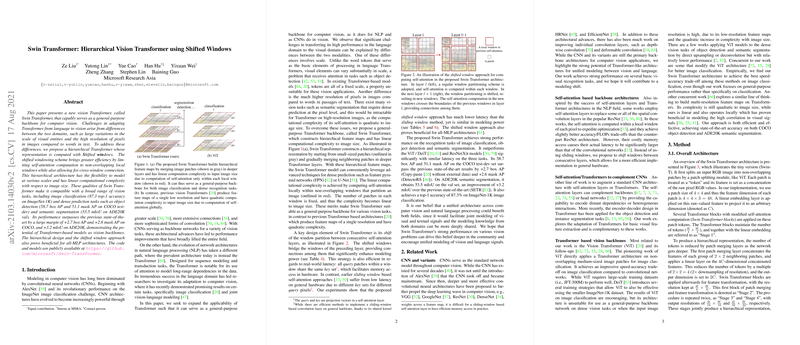Swin Transformer: Hierarchical Vision Transformer using Shifted Windows
The presented paper explores the Swin Transformer, a novel vision Transformer model designed to serve as a versatile backbone for various computer vision tasks. This model addresses the inherent challenges posed by adapting Transformers, originally developed for NLP, to vision problems. These challenges primarily stem from the significant differences in domain characteristics, such as the scale variability of visual entities and the high pixel resolution of images as opposed to the relatively lower resolution and fixed scale of textual tokens.
Key Characteristics of the Swin Transformer
The Swin Transformer is distinguished by its hierarchical structure and the use of shifted windows for computing self-attention.
- Hierarchical Representation: By partitioning images into non-overlapping patches and iteratively merging them to form hierarchical representations, the Swin Transformer encompasses the flexibility to model visuals at various scales. This hierarchical approach enables the model to effectively manage the large variations in the scale of visual entities, similar to techniques like Feature Pyramid Networks (FPN).
- Shifted Windows: The computation of self-attention is confined within local windows, drastically reducing computational complexity from quadratic to linear with respect to image size. The windows are alternated between non-overlapping and shifted configurations across different layers, ensuring cross-window connections that are critical for effective feature representation. This window-shifting strategy is found to improve performance significantly, providing a better balance between accuracy and efficiency.
Performance and Comparisons
The Swin Transformer demonstrates superior performance across several vision tasks, outperforming previous state-of-the-art models in both efficiency and accuracy.
- Image Classification: On the ImageNet-1K dataset, the Swin-T variant achieves a top-1 accuracy of 81.3%, significantly higher than comparable convolutional and Transformer-based models (e.g., ResNet and DeiT). When extended to ImageNet-22K pre-training and subsequent fine-tuning, the Swin-B and Swin-L models reach top-1 accuracies of 86.4% and 87.3%, respectively.
- Object Detection and Segmentation: Utilizing frameworks such as Cascade Mask R-CNN and ATSS on the COCO dataset, the Swin Transformer achieves box AP scores of up to 58.7 and mask AP scores of 51.1, surpassing previous best results by considerable margins. Specifically, the Swin-L model with advanced configurations (HTC++) demonstrates outstanding performance, recording significant gains in both box AP and mask AP.
- Semantic Segmentation: On the ADE20K dataset, the Swin Transformer yields compelling results, with the Swin-L model achieving 53.5 mIoU, which surpasses the previous best-performing model by 3.2 mIoU.
Implications and Future Directions
The Swin Transformer's success in vision tasks suggests that the model's hierarchical design and shifted window approach are effective strategies for adapting Transformer architectures to computer vision. This not only opens avenues for further optimization in vision-specific models but also signals potential for unified models that span both vision and language domains. Such unified models can leverage the strengths of both fields, fostering advancements in multi-modal learning and joint visual-textual tasks.
Moreover, the principles underlying the Swin Transformer, particularly the shifted window-based self-attention, could be explored for efficiency enhancements in NLP applications. This approach presents a promising direction for future research, aiming to harmonize the application of Transformers across varying data modalities while preserving computational efficiency.
Conclusion
The Swin Transformer represents a significant advancement in the utilization of Transformer models for computer vision, achieving state-of-the-art results and offering new insights into efficient self-attention mechanisms. Its hierarchical and shifted window-based design not only addresses the unique challenges of vision tasks but also sets a foundation for future cross-domain Transformer architectures. As both practical and theoretical implications unfold, the Swin Transformer is poised to influence ongoing developments in AI and machine learning, driving forward innovation in model design and application scope.
